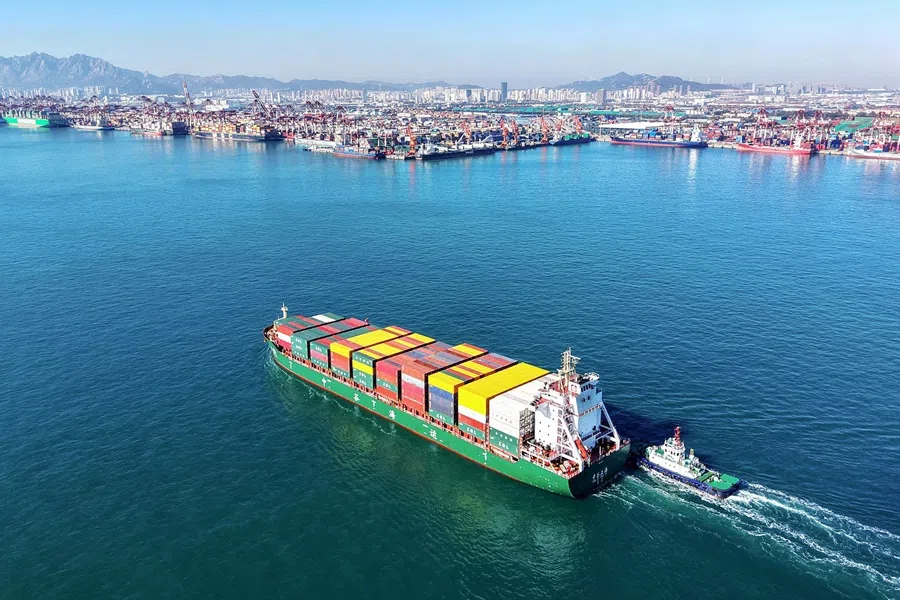China’s thorium breakthrough could power ships for ten years on a single charge
China’s recent breakthrough in converting thorium to uranium could potentially free it from reliance on imported uranium. Lianhe Zaobao correspondent Yu Zeyuan takes a look at the advantages of thorium as a nuclear fuel and how it could change China’s position in the global energy landscape.

The Chinese Academy of Sciences announced on 1 November that the country has successfully achieved the first-ever thorium-to-uranium nuclear fuel conversion in a 2-MW thermal liquid-fuelled thorium molten salt reactor located in Minqin county of Gansu province. It is currently the world’s only operating molten salt reactor to have successfully introduced thorium fuel, providing initial proof of the technical feasibility of using thorium resources in molten salt nuclear systems.
Thorium: by-product of rare earth extraction
This breakthrough is seen as China’s “trump card” in fourth-generation nuclear energy, marking its mastery of a key technology that enables it to leap ahead, freeing China from dependence on imported uranium and offering a new solution for the country’s energy security.
China’s nuclear energy development has long been constrained by its limited uranium resources. A typical 1-gigawatt nuclear power plant consumes around 200 tonnes of uranium oxide (U₃O₈) per year, yet more than 80% of China’s uranium supply relies on imports — leaving the country exposed to geopolitical risks. After the Fukushima nuclear accident in 2011, global uranium prices fluctuated sharply, forcing some Chinese nuclear projects to slow due to uncertainty in fuel supply.
Chinese media have similarly reported that the country’s identified thorium resources total around 1.3–1.4 million tonnes.
At the same time, China — already known to hold the world’s largest thorium reserves — may possess far more than previously estimated. A geological review study found that waste from just five years of mining at Inner Mongolia’s Bayan Obo site contains enough thorium to power US households for over a millennium, with the deposit potentially yielding up to one million tonnes — enough to fuel China for tens of thousands of years. Chinese media have similarly reported that the country’s identified thorium resources total around 1.3–1.4 million tonnes.
In many rare-earth mineral deposits, thorium occurs naturally as a by-product — for instance, monazite can contain up to 7% thorium. Although recovery rates vary, the overlap between rare-earth extraction and thorium enrichment means that China’s rare-earth industry could also become a future source of nuclear fuel.
Nuclear reactors generate energy through fission — the splitting of atoms in a controlled chain reaction. Thorium itself is not fissile but “fertile”: when bombarded with neutrons, it transforms into uranium-233, a fissile isotope capable of sustaining power generation.
Compared with conventional uranium nuclear power plants, thorium molten salt reactors offer major advantages in safety and site flexibility. Traditional uranium reactors are heavy water users — a typical 1-GW nuclear unit consumes several thousand tonnes of cooling water per hour to prevent the reactor core from overheating and melting down due to the immense heat generated.
Meanwhile, thorium molten salt reactors use high-temperature molten salts that remain stable in liquid form at 600-700°C. During operation, no external water supply is needed — the molten salt naturally circulates within a closed loop, continuously moving heat away from the core. This fundamentally eliminates the safety risks associated with cooling system failure.
After tens of thousands of corrosion tests, the Chinese research team finally settled on an “anti-corrosion formula” to develop a nickel-based alloy material that would extend the lifespan of the pipes to more than 10 years.
Stable and clean energy
China is not the first country to explore thorium as a nuclear fuel. During the Cold War, the US pioneered thorium molten salt reactor research but eventually abandoned it, as thorium could not be used to produce nuclear weapons, shifting instead to uranium-based reactors. The Soviet Union, India, and others also experimented with thorium reactors but were ultimately constrained by technical challenges such as molten salt corrosion and the complexity of online fuel reprocessing — the continuous separation and recycling of fuel from the reactor’s molten salt while it remains in operation.
In 2011, China incorporated thorium molten salt reactors into its national strategic pilot projects, bringing together over 20 research institutions including the Chinese Academy of Sciences’ Shanghai Institute of Applied Physics for a collaborative effort. This has recently resulted in a significant breakthrough.
The most challenging issue was molten salt corrosion. High-temperature fluoride salts can dissolve most metals, which previously caused the piping of an experimental reactor in the US to fail within three months. After tens of thousands of corrosion tests, the Chinese research team finally settled on an “anti-corrosion formula” to develop a nickel-based alloy material that would extend the lifespan of the pipes to more than 10 years.
Thorium molten salt reactors do not require large amounts of water, so unlike traditional nuclear power stations, they do not need to be built near the sea or major rivers. Instead, they can be constructed in remote deserts. Once the technology matures, they can be extensively built in China’s arid inland regions, providing a supply of stable and clean energy.
China has already begun research into nuclear power for ships, which when applied to ocean-going cargo ships, could enable them to sail for ten years on a single refill of thorium fuel, with a negligible carbon emission.
Moreover, thorium molten salt reactors are compact and have high power density, allowing for modular design as “nuclear power packs”. China has already begun research into nuclear power for ships, which when applied to ocean-going cargo ships, could enable them to sail for ten years on a single refill of thorium fuel, with a negligible carbon emission. This technology could also potentially power polar research stations, lunar bases and even be used in military projects such as aircraft carriers.
China’s plan forward
China plans to construct its thorium molten salt reactor in three steps: the first step is to complete a 2-MW experimental reactor by 2025 to achieve thorium-to-uranium conversion and stable operation, as well as to gather key data. The second step involves constructing a 10-MW small modular demonstration reactor by 2029 to verify commercial viability and establish a core infrastructure supply chain. The third step is to advance the construction of power stations in the 100-MW range by 2035, enabling large-scale application in thorium-rich areas such as Gansu and Xinjiang and spurring the development of equipment manufacturing, molten salt materials, as well as other industrial clusters.
China has recently achieved a significant breakthrough in nuclear fusion technology.
Additionally, China has recently achieved a significant breakthrough in nuclear fusion technology. On 1 October, the Dewar base, a key component of the compact fusion experiment device project, was successfully and precisely installed in the main hall of the device in Hefei, Anhui. The project is expected to be completed in 2027 with the first demonstration of fusion power generation, and there is hope that by 2030, the first lamp will be lit by power generated from nuclear fusion.
If China were to successfully leap ahead in the nuclear energy field, it would further consolidate its leading position in clean energy and give it the potential to change the energy landscape in China and even globally.








